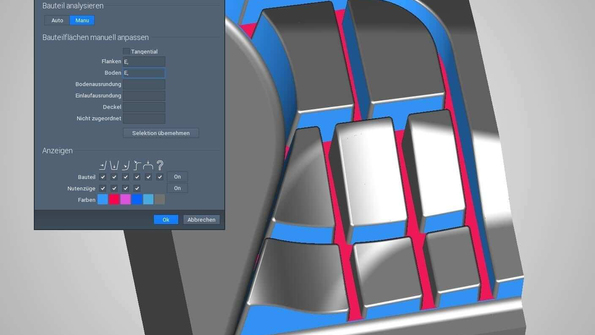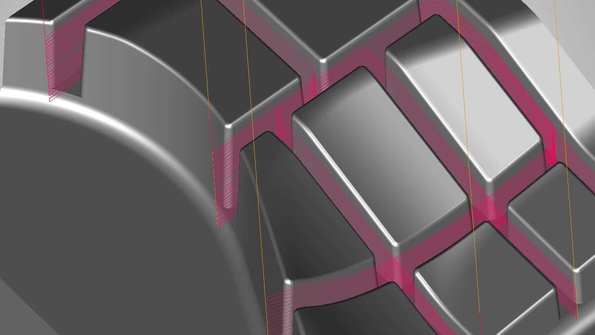-
Software
-
CAM software
- Tebis Automill
- CNC programming
- CNC automation
- CNC simulator
- Multiple setup
- Robotic machining
- CNC drilling
- Deep-hole drilling
- Combined turn-milling
- CNC turning
- Turn-milling
- 2.5D milling
- 3D milling
- 5-axis milling
- Slot milling
- Trimming
- HPC milling
- HFC milling
- Circle-segment cutters
- Sinker EDM
- Wire EDM
- 3D laser cutting
- Laser hardening
- Laser weld cladding
- CAD software
- CAQ software
- MES software
- Products
-
CAM software
- Services
- Consulting
- Sectors
- References
- Company
- News

-

Rib and slot machining
Interview with Helmut Vergin, Product Manager
Helmut Vergin, Tebis Product Manager for CAM and automation processes, explains how Tebis integrates the machining of ribs and slots in CAD/CAM processes. One example is the rib and slot machining function. This enables fast and efficient machining of ribs and slots with outstanding quality. We talked to Helmut Vergin, Product Manager at Tebis AG in Martinsried for all CAD topics and for automation processes since 2008, to learn first-hand about a concept that precisely synchronizes CAD and CAM functionalities.
Mr. Vergin, what special challenges does rib and slot machining pose?
Together with project partners, we've determined that the greatest expenditure in slot machining has previously been in the preparation phase. At the beginning of the process chain in particular, fundamental questions must be answered. What is a slot, anyway? How deep is the slot? Which slots can be milled and which ones require eroding? What strategies, materials, tools, and machines are used? Do we mill the entire slot or do we first rough? And finally: How does the NC programmer use the analysis results during programming? If these questions are answered solely on the basis of the experience of individual users, this phase is extremely time-consuming. Automation is possible only with great difficulty.
And what are your answers?
In keeping with the Tebis motto "As much automation as possible, as much flexibility as necessary," the preparation and milling functions in our new concept create a coherent overall system. CAD and CAM functions go hand in hand.
What does this mean specifically?
First of all, a powerful analysis and preparation function that we called SLOT automatically recognizes the component sections that are most suited for slot machining. It divides the geometry into suitable machining areas, such as bottom, flanks, and radii. Elements that can be processed in a single action are logically combined into entire slot successions and extracted from the component. Other CAD functions like our FILL function for the fast and easy creation of fill surfaces help to prepare for NC programming. Of course, the user can interactively intervene at any time and influence the categorization of the individual elements. By the way, this function is part of the NC Geometry Preparation add on.

And how do you get from here to NC programming?
The rib and slot machining is fully integrated into our automation concept. As in all Tebis CAM functions, you can define appropriate templates for every machining strategy in the new slot machining function. The corresponding machining sequence is specified in this template. All settings and technology values are already defined. All settings and technology values are already defined. The system automatically assigns the right machines, tools, and materials. The programmer just needs to select the elements to be machined.
But there could be a lot of those…
We've thought about that, too. During the preparation phase, you can specify fixed rules for naming and layer structure when saving the slot successions. This enables the options of automatic element selection, which significantly facilitates choosing the elements.
Can rib and slot milling be easily combined with other CAM functions?
Of course. The MSLOT function comprises roughing and finishing functions for slots and negative ribs, which can be combined with all Tebis CAM functions as required. There are no limits, even when machining complex components. The function itself comprises several strategies to process the center curves output by the SLOT function. MSLOT is integrated in the Mold and Die Premium and Mechanical Engineering Pro industry packages.
What do you need the center curve for?
Tebis machines slots on the basis of central center paths. The material can be removed much faster compared with traditional plane-by-plane machining with multiple lateral stepovers. With no additional design effort, you avoid interruptions in the NC paths if fill surfaces are missing from the slot intersections. This enables the very easy generation of a path layout that is optimally adapted for the geometry.

And this works with all tools?
Modern roughing cutters can machine slots with only one path in full width. However, the integrated trochoidal full-width avoidance ensures that the component can be machined with traditional tools while also saving time.
Are there plans to expand the rib and slot machining function in the future?
In a future step, we want to integrate the function for creating closing faces into the SLOT function. It will then be possible to automatically create lateral fill faces, cover faces, and more. Our milling functions will even better manage the special requirements of rib and slot machining. For example, we want to provide roughing and finishing functions for thin-walled components.
What would be your concluding message to the users?
Many components that previously could be manufactured only with electro-erosive processes now be manufactured mostly using milling techniques. The machines are more modern, the controllers are better, and the tools are more powerful. However, although milling slots saves time and costs, many mold manufacturers prefer traditional erosive methods because of the reasons given earlier. With our new concept, we want to provide a tool for choosing the optimal manufacturing method for everyone who wants to make the most of the potentials in slot machining. Thanks to the new functions, the user can better understand the entire process, map it in the virtual world, and derive the optimal strategy for the subsequent CAM machining.
Mr. Vergin, thank you for this conversation.
 Helmut Vergin, Produktmanager der Tebis AG
Helmut Vergin, Produktmanager der Tebis AG
